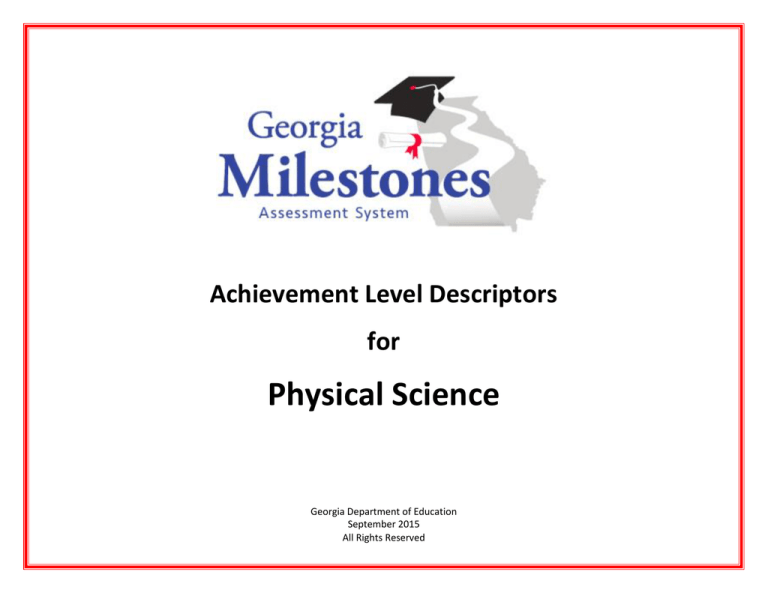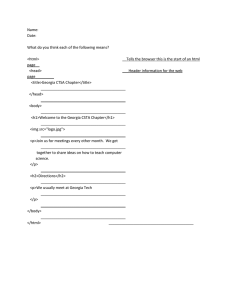Physical Science - Georgia Department of Education
advertisement

Achievement Level Descriptors for Physical Science Georgia Department of Education September 2015 All Rights Reserved Physical Science EOC Georgia End-of-Course: Science September 2015 Achievement Levels and Achievement Level Descriptors With the implementation of the Georgia Milestones Assessment System, Georgia educators have developed four achievement levels to describe student mastery and command of the knowledge and skills outlined in Georgia’s content standards. Most students have at least some knowledge of the content described in the content standards; however, achievement levels succinctly describe how much mastery a student has. Achievement levels give meaning and context to scale scores by describing the knowledge and skills students must demonstrate to achieve each level. The four achievement levels on Georgia Milestones are Beginning Learner, Developing Learner, Proficient Learner, and Distinguished Learner. The general meaning of each of the four levels is provided below: Beginning Learners do not yet demonstrate proficiency in the knowledge and skills necessary at this grade level/course of learning, as specified in Georgia’s content standards. The students need substantial academic support to be prepared for the next grade level or course and to be on track for college and career readiness. Developing Learners demonstrate partial proficiency in the knowledge and skills necessary at this grade level/course of learning, as specified in Georgia’s content standards. The students need additional academic support to ensure success in the next grade level or course and to be on track for college and career readiness. Proficient Learners demonstrate proficiency in the knowledge and skills necessary at this grade level/course of learning, as specified in Georgia’s content standards. The students are prepared for the next grade level or course and are on track for college and career readiness. Distinguished Learners demonstrate advanced proficiency in the knowledge and skills necessary at this grade level/course of learning, as specified in Georgia’s content standards. The students are well prepared for the next grade level or course and are well prepared for college and career readiness. More detailed and content-specific concepts and skills are provided for each grade, content area, and course in the Achievement Level Descriptors (ALDs). ALDs are narrative descriptions of the knowledge and skills expected at each of the four achievement levels and were developed for each grade level, content area, and course by committees of Georgia educators in March 2015 and July 2015. The ALDs are based on the state-adopted content standards. ALDs show a progression of knowledge and skills for which students must demonstrate competency across the achievement levels. It is important to understand that a student should demonstrate mastery of the knowledge and skills within his/her achievement level as well as all content and skills in any achievement levels that precede his/her own, if any. For example, a Proficient Learner should also possess the knowledge and skills of a Developing Learner and a Beginning Learner. Georgia Department of Education Page 2 of 6 All Rights Reserved Physical Science EOC Georgia End-of-Course: Science September 2015 POLICY ALDs Beginning Learner Beginning Learners do not yet demonstrate proficiency in the knowledge and skills necessary at this grade level/course of learning, as specified in Georgia’s content standards. The students need substantial academic support to be prepared for the next grade level or course and to be on track for college and career readiness. Developing Learner Developing Learners demonstrate partial proficiency in the knowledge and skills necessary at this grade level/course of learning, as specified in Georgia’s content standards. The students need additional academic support to ensure success in the next grade level or course and to be on track for college and career readiness. Proficient Learner Proficient Learners demonstrate proficiency in the knowledge and skills necessary at this grade level/course of learning, as specified in Georgia’s content standards. The students are prepared for the next grade level or course and are on track for college and career readiness. Distinguished Learner Distinguished Learners demonstrate advanced proficiency in the knowledge and skills necessary at this grade level/course of learning, as specified in Georgia’s content standards. The students are well prepared for the next grade level or course and are well prepared for college and career readiness. RANGE ALDs Beginning Learner A student who achieves at the Beginning Learner level demonstrates minimal command of the course standards. The pattern exhibited by student responses indicates that students are most likely able to recognize the differences between atoms and molecules; describe the movement of particles in solids, liquids, gases, and plasmas; use the Periodic Table of the Elements to locate metals, nonmetals, and metalloids; describe the Law of Conservation of Matter; describe energy transformations; explain that colors are distinguished by differences in wavelengths/frequencies; Georgia Department of Education Developing Learner A student who achieves at the Developing Learner level demonstrates partial command of the course standards. The pattern exhibited by student responses indicates that students are most likely able to identify the structure of the atom; recognize that electrons are involved in bonding; compare and contrast the atomic/molecular motion of solids, liquids, gases, and plasmas; explore the nature of matter, its classifications, and the system for naming types of matter; describe the three types of heat energy transfer (radiation, conduction, convection); investigate the properties of Proficient Learner A student who achieves at the Proficient Learner level demonstrates proficiency of the course standards. The pattern exhibited by student responses indicates that students are most likely able to examine the structure of the atom in terms of proton, electron, and neutron locations, atomic mass and atomic number, and atoms with different numbers of neutrons (isotopes) and explain the relationship of the proton number to the element’s identity; compare and contrast ionic and covalent bonds in terms of electron movement; identify the types of radioactivity and differentiate Page 3 of 6 Distinguished Learner A student who achieves at the Distinguished Learner level demonstrates advanced proficiency of the course standards. The pattern exhibited by student responses indicates that students are most likely able to describe nuclear energy, its practical application as an alternative energy source, and its potential problems; differentiate between alpha and beta particles and gamma radiation; predict formulas for stable binary ionic compounds based on balance of charges; describe solutions in terms of concentration and conductivity; demonstrate that solubility is All Rights Reserved Physical Science EOC describe how the behavior of waves is affected by medium (air, liquid water, solids); explain how the parts of a wave are affected by changes in amplitude and pitch; demonstrate series and parallel circuits; identify three types of heat transfer; recognize simple machines that make work easier; recognize appropriate laboratory techniques; suggest reasonable hypotheses for identified problems; recognize possible effects of measurement and calculation errors; identify reactants and products in a chemical reaction; identify simple machines; recognize examples of forces; and recognize that many electrons produce electricity. Georgia End-of-Course: Science solutions by observing factors affecting the rate at which a solute dissolves in a specific solvent; identify phase changes; identify energy transformations within a system, such as lighting a match; recognize that all waves transfer energy; recognize appropriate solutions for solving scientific problems; use technology to develop tables and graphs; use dimensional analysis to solve problems; use data as evidence to support scientific claims; recognize a balanced equation; recognize balanced and unbalanced forces; describe electromagnetic and mechanical waves; identify methods of electron transfer; define voltage, resistance, and current; identify types of circuits; and describe a permanent magnet. Georgia Department of Education Page 4 of 6 between fission and fusion; explain the process of half-life as it relates to radioactive decay; demonstrate the effect of balanced and unbalanced forces on an object; determine the trends in the number of valence electrons, types of ions formed by representative elements, and phases at room temperature; use the Periodic Table of the Elements to predict the properties for representative elements; relate temperature, pressure, and volume of gases to the behavior of gases; use IUPAC nomenclature for transitions between chemical names and chemical formulas of binary ionic compounds (containing representative elements) and binary covalent compounds (carbon dioxide, carbon tetrachloride); apply the Law of Conservation of Matter in a chemical reaction; calculate density when given a means to determine a substance’s mass and volume; balance chemical equations (synthesis, decomposition, single replacement, double September 2015 related to temperature by constructing a solubility curve; describe molecular motion as it relates to thermal energy changes in terms of conduction, convection, and radiation; explain the flow of energy in phase changes through the use of a phase diagram; explain magnetism and/or its relationship to the movement of electrical charge as it relates to electromagnets, including simple motors and permanent magnets; solve scientific problems by substituting quantitative values or using dimensional analysis and/or simple algebraic formulas as appropriate; determine the half-life given a graph of radioactive decay; relate frequency and wavelength to the energy of different types of electromagnetic waves and mechanical waves; compare and contrast the characteristics of electromagnetic and mechanical (sound) waves; predict which machine would have the greatest mechanical advantage; calculate the velocity of a All Rights Reserved Physical Science EOC Georgia End-of-Course: Science Georgia Department of Education replacement); describe solutions in terms of solute/solvent; compare and contrast the components and properties of acids and bases; determine whether common household substances are acidic, basic, or neutral; differentiate between conduction, convection, and radiation; determine the heat capacity of a substance using mass, specific heat, and temperature; compare phase changes; calculate velocity and acceleration; apply Newton’s three laws to everyday situations; relate falling objects to gravitational force; explain the difference between mass and weight; calculate amounts of work and mechanical advantage for simple machines; investigate the phenomena of reflection, refraction, interference, and diffraction; relate the speed of sound to different mediums; explain the Doppler Effect in terms of everyday interactions; investigate static electricity in terms of friction, induction, and Page 5 of 6 September 2015 falling object; apply alternating and direct current in a real-world scenario; solve problems related to voltage, resistance, and current; explain how factors affect the strength of an electromagnet; and predict outcomes given series and parallel circuits. All Rights Reserved Physical Science EOC Georgia End-of-Course: Science Georgia Department of Education Page 6 of 6 September 2015 conduction; explain the flow of electrons in terms of alternating and direct current; explain the relationships between voltage, resistance, and current; compare and contrast simple series and parallel circuits; describe an electromagnet; recognize that different explanations can be used to explain a single set of data; and use technology to develop and test experimental or mathematical models. All Rights Reserved

